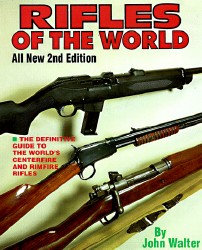CRUFFLER.COM
presents
HISTORIC
FIREARM OF THE MONTH,
February
2000:
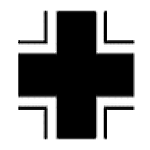 |
 |
 |
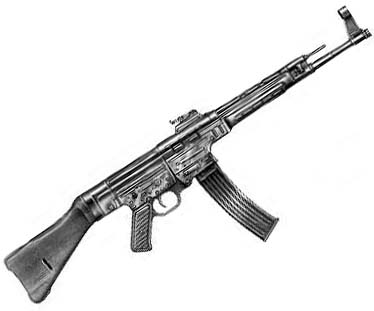
Image credit: http://www.sturmgewehr.com |
Type:
Select Fire Assault Rifle
System of Operation: Gas Caliber: 7.9mm Kurz Patrone (7.9x33mm) Capacity: 30 round detachable box magazine Sights: Tangent U-notch rear, Blade front Length: 37" Weight (unloaded): 10.85 pounds Barrel: 14.35", 4 groove, right-hand twist |
EARLY
DEVELOPMENT
During
the initial phases of German rearmament, there were factions within the
military establishment in favor of pursuing an intermediate cartridge and
a corresponding rifle to go along with it. At the time, the German
military had been using the 7.9x57mm
|
|
"S-patrone" (Spitzgeschoss Patrone - "Heavy Pointed Bullet Cartridge") for more than thirty years. The proponents of the intermediate cartridge argued that the service cartridge was actually less than ideal for typical combat situations. Since, the theory went, most infantry action took place at ranges under 400 meters, the long range potential of the service cartridge and rifle were wasted. The ideal solution was to develop a shortened cartridge that would be effective at realistic combat ranges, but would be within certain size, range, and manufacturing guidelines. Additional factors influencing this trend were the economies of production involved with making smaller rounds. |
The earliest
known incarnation of the intermediate cartridge was an 8x46mm round manufactured
by RWS in 1934. This was followed in 1935 by a 7.75x40mm cartridge
from Geco. Testing of the Geco 7.75mm round continued until 1939,
using a series of specially designed automatic carbines from the Vollmer
firm, when both the round and the carbine were ultimately rejected.
Also developed was a 7x39mm round from Deutsche Waffen und Munitionsfabriken
(DWM). This round was originally developed for the Luftwaffe for
an experimental Bergmann machine gun. Despite this, it was tested
in an experimental Walther "machine carbine" that was submitted to the
government for testing in 1937 and 1938. (The same round was also
tested in 1943 by Mauser in the experimental Gerat 06H machine carbine.)
The only known short cartridge weapons systems evaluated in the 1934 -
1940 period were those automatic carbines submitted to the Heereswaffenamt
by Vollmer and Walther.

Vollmer Automatic Carbine, M35 Image Credit: Senich, Peter R., The German Assault Rifle 1935 - 1945, Paladin Press (Boulder, Colorado, 1987) Page 2 |

Walther Automatic Carbine Image Credit: Senich, Peter R., The German Assault Rifle 1935 - 1945, Paladin Press (Boulder, Colorado, 1987) Page 3 |
Despite the successes of the intermediate cartridges, the German military continued to reject the idea of an intermediate round for general service issue. The attitude of the senior staff, forged in World War One and before, was that long range rifle and machine gun fire would be a critical factor in future conflicts. However, in 1938, the Heereswaffenamt bucked the General Staff, and issued a a contract to the Polte Cartridge Factory in Magdeburg for the development of an acceptable intermediate cartridge.
Polte's research centered on cartridges of shorter case length (30 - 35mm) and with lighter projectiles than previously used. Rather than creating an entirely new design, Polte opted to retain many characteristics of the existing 7.92x57mm military cartridge. Indeed, the new round which was accepted in 1941 would be shorter and lighter than the service cartridge, but would share many dimensional characteristics. The intermediate cartridge was assigned the nomenclature "7.9 Infanterie Kurz Patrone," or Infantry Short Cartridge, and used a projectile of 7.92mm in diameter with a final case length of 33mm.
At the same time as the contract had been let to Polte, the Heereswaffenamt also placed a contract with the C.G. Haenel Waffen un Fahrrad Fabrik of Suhl for the development of a shoulder weapon to use an intermediate cartridge. While there is no hard evidence to suggest why the Haenel firm had been suggested for this work, it is interesting to note that the famous automatic weapons designer Hugo Schmeisser was serving as the director of Haenel's design group at the time. Basic requirements for the new weapon included that it be selective fire, and capable of acceptable performance out to 800 meters. To differentiate it from the submachinegun, the new rifle was given the designation of " Maschinenkarabiner (machine carbine)," or MKb.
The MKb was originally intended to replace the bolt action carbine, submachinegun, and the light machinegun as well. As a result, the requirements called for a light, select fire shoulder weapon that could be made on simple metal forming and machining equipment such as that currently used for rifle or submachinegun manufacture. Eventually, the requirements were expanded to the following criteria:
1. Reliability in severe cold and desert conditions
2. Adequate protection against dust and dirt
3. Simple mechanism
4. Weight less than or equal to the standard infantry rifle
5. Shorter length than the standard infantry rifle
6. Trajectory comparable to that of the rifle out to 600 meters
7. Accurate semiautomatic fire out to 400 meters
8. Effective short burst fire out to 400 meters
9. 350 - 450 round per minute cyclic rate
10. Controlled fire in full automatic mode
11. Provision for mounting a grenade launcher
.jpg)
Image Credit: Senich, Peter R., The German Assault Rifle 1935 - 1945, Paladin Press (Boulder, Colorado, 1987) Page 10 |
During the development process, Haenel turned to Merz Werke of Frankfurt for expertise and assistance with the sheet metal forming processes for the new rifle. Meanwhile, in Zella-Mehlis, the Walther firm had become aware of the MKb program, and submitted a gas-operated turning bolt |
MKb
42(H)
| The original Haenel produced prototype weapons incorporated many of the features of earlier Schmeisser designs, such as the MP38 and MP40 submachineguns. The prototypes featured a simple gas operation system with the gas tube and pistol positioned above the barrel. The rifle used |
.jpg) Image Credit: Senich, Peter R., The German Assault Rifle 1935 - 1945, Paladin Press (Boulder, Colorado, 1987) Page 32 |
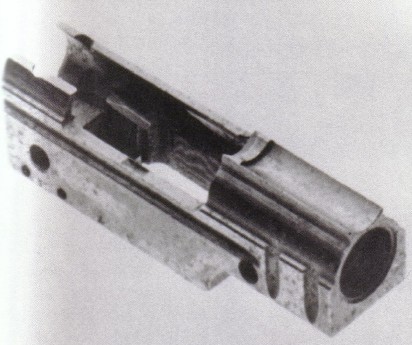
Image Credit: Senich, Peter R., The German Assault Rifle 1935 - 1945, Paladin Press (Boulder, Colorado, 1987) Page 87 |
The
receiver was entirely enclosed in the rifle's sheet metal main group housing,
and was secured by means of locating pins and indentation into which the
sheet metal was pressed. Disassembly of the receiver from the housing
was not contemplated, and required the destruction of the weapon to achieve.
The fire control group was contained in a stamped sheet metal housing hinged to the bottom of the receiver, which also served as the trigger guard and pistol grip. A cross-bolt |
Based on experiences with the Mkb 42 (H) prototypes, the Heereswaffenamt mandated various changes to the design. These included provisions for mounting the standard service bayonet, as well as increasing the diameter and pitch of the muzzle threads. By November 1942, deliveries of the new MKb were reaching troops in significant numbers. Initial reports from the field were very favorable, with the only negative comments being the high prone firing position necessitated by the long magazine and the brilliant muzzle flash during night firing. Modifications to the MKb 42(H) also included a spring loaded ejection port cover (much like that found on M16 rifles) to keep debris out of the mechanism, and telescope mounting rails on the rear sight block. A total of 11,853 Mkb 42(H)'s were produced between November 1942 and September 1943 when MKb production gave way to the improved MP43 series.
MP43
| The Maschinenpistole 43 (MP43) prototype was developed in the final months of 1942 and was an evolution of the MKb 42(H). Improvements included a change to a closed bolt firing system. This necessitated the replacement of the striker firing system to one with an internal hammer. The gas |
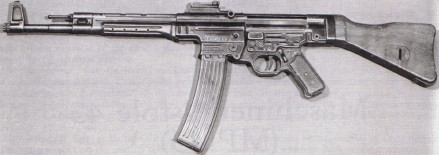
MP43 Image Credit: Senich, Peter R., The German Assault Rifle 1935 - 1945, Paladin Press (Boulder, Colorado, 1987) Page 60 |
Most
interesting is the change in nomenclature from the machine carbine to machine
pistol, which had heretofore indicated a submachinegun suitable for use
at short distances only. This terminology issue dates to the prewar
period, when, in German military circles, a machine carbine came to mean
a short, semiautomatic rifle without an automatic fire capability.
Despite this, when the Heereswaffenamt specifications for a new multipurpose
infantry shoulder arm were outlined in the late 1930's, the term machine
carbine was believed to best characterize the idea. However, in early
1942, Adolf Hitler began to deeply involve himself in the development and
introduction of new weapons. Apparently, Hitler expressed more than
a little displeasure at the thought of introducing an entirely new weapon
and cartridge, and ordered work to cease on the machine carbine program.
Despite this, certain groups within the Heereswaffenamt were more interested
in fielding effective weaponry than respecting the Fuhrer's unreasonable
orders. Therefore, the project continued on a more or less covert
basis, with all references to the MKb being dropped altogether, and work
continued under the designations MP42 and MP43 - the idea being to convey
that these referred to improvements in existing weapons. Hitler was
eventually clued in as to the true nature of the MP43 project and ordered
an immediate termination to the project. However, a "special series"
limited to those quantities of guns and parts already in production was
authorized in March 1943. The forces behind the intermediate rifle
concept took a very liberal view of what was already "in production."
As an epilogue, when faced with very positive combat evaluations of the
MP43 from Russia, Hitler finally changed his views, and in September 1943,
the project was given official blessing and could continue openly.
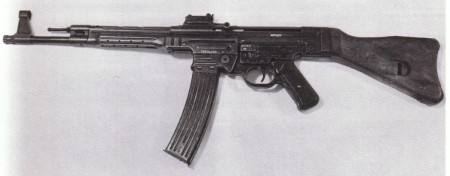
Image Credit: Senich, Peter R., The German Assault Rifle 1935 - 1945, Paladin Press (Boulder, Colorado, 1987) Page 69 |
The MP43/1 variant differed only in the nature of the threads at the muzzle. The MP43/1 used the same large diameter threads and muzzle nut as the MKb 42(H), making it possible to use the MKb 42(H) grenade launcher attachment. Additionally, the MP43/1 had a long, thick foresight base |
While earlier MP43's were blued, later production variants are all parkerized, or are a combination of blued and parkerized parts.
MP44
| The MP44, while the most common German assault rifle, was nothing more than a renamed MP43. With a good number of positive evaluations on hand, Hitler did a complete about face with respect to his opinions of the MP43. On April 6, 1944, Hitler issued the following decree: |
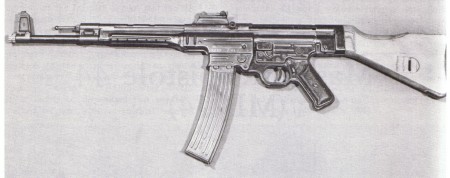 Image Credit: Senich, Peter R., The German Assault Rifle 1935 - 1945, Paladin Press (Boulder, Colorado, 1987) Page 74 |
"a) The former MG42 is to retain the same designationStG44
b) The former self-loading rifle, known as the Gewehr 43, shall receive the designation Karabiner 43 (K43).
c) The former new MP, known as the MP43, shall receive the designation MP44.
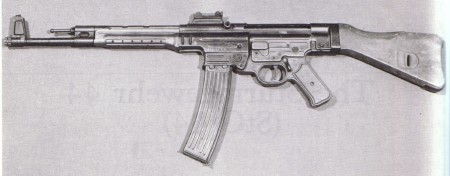
Image Credit: Senich, Peter R., The German Assault Rifle 1935 - 1945, Paladin Press (Boulder, Colorado, 1987) Page 80 |
By mid to late 1944, it was clear that the tide of the war had turned against Germany. As a result, official efforts to exploit the propaganda value of new weapons resulted in another change in model designation. In December 1944, the official nomenclature of the MP44 was changed to Sturmgewehr 44 (StG44) - "Assault Rifle 44." |
In the end, some 425,977 Sturmgewehr variants of all types were produced. The StG44 was the original "assault rifle," and the first weapon of this classification to see combat usage. The German Army considered it to be a complete success wherever it was employed. The lineal descendants of the StG44 still line the world's arsenals.
BIBLIOGRAPHY
Senich, Peter R., The German Assault Rifle, 1935 - 1945, (Paladin Press, Boulder, Colorado: 1987)
Walter, John, Rifles of the World, 2nd Edition, (Krause Publications, Iola, Wisconsin: 1998)
The
German Assault Rifle, 1935 - 1945 is available from IDSA Books.
Click on the image to order:
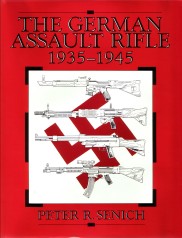
Rifles
of the World, 2nd Edition is available from Amazon.com.
Click on the image to order:
